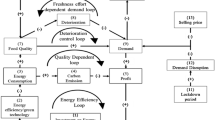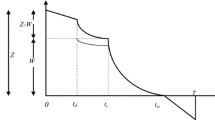Abstract
The retailer frequently leases an additional warehouse to avoid stockout situations. The mathematical framework for multiple warehouses handling decaying products within a retail setting is presented in this paper. The retailer discounts less-effective products when deterioration begins, encouraging customers to purchase them. This reduces waste and promotes a more sustainable approach towards inventory management. In addition to focusing on sustainable marketing strategies that support environmentally friendly products, the article explores the link between advertising, product pricing, and demand, emphasizing the considerable influence of promotions and price cuts. The study also discusses a trade credit policy, where the supplier grants the retailer a specified credit period for settling the account. The study aims to increase the store’s operational efficiency and minimize overall costs by establishing global optimality for important decision factors such as credit period, storage capacity, and replenishment time. Numerical examples and sensitivity analyses for key factors are provided to explore the impact on the system’s optimal total cost, along with managerial insights.





Similar content being viewed by others
Data Availability
The data used to support the findings of this study are included in the article.
Abbreviations
- EOQ:
-
Economic order quantity
- OW:
-
Own warehouse
- RW:
-
Rented warehouse
- TW:
-
Two warehouses
References
Aarya DD, Rajoria YK, Gupta N, Raghav YS, Rathee R, Boadh R, Kumar A (2022) Selling price, time-dependent demand, and variable holding cost inventory model with two storage facilities. Materials Today: Proceedings 56:245–251
Aljazzar SM, Jaber MY, Moussawi-Haidar L (2017) Coordination of a three-level supply chain (supplier–manufacturer–retailer) with permissible delay in payments and price discounts. Appl Math Model 48:289–302
Burwell TH, Dave DS, Fitzpatrick KE, Roy MR (1997) Economic lot size model for price-dependent demand under quantity and freight discounts. Int J Prod Econ 48(2):141–155
Chakraborty D, Jana DK, Roy TK (2020) Multi-warehouse partial backlogging inventory system with inflation for non-instantaneous deteriorating multi-item under an imprecise environment. Soft Comput 24:14471–14490
De SK, Mahata GC, Maity S (2021) Carbon emission sensitive deteriorating inventory model with trade credit under the volumetric fuzzy system. Int J Intell Syst 36:7563–7590
Debnath BK, Majumder P, Bera UK (2018) Two warehouse inventory models of breakable items with stock-dependent demand under trade credit policy concerning both supplier and retailer. Int J Logist Syst Manag 31:151–166
Dolai M, Banu A, Mondal SK (2023) Analyzing an imperfect production inventory model for green products considering learning effect on screening process under advertisement dependent credit period. J Ind Manag Optim 19:1–29
Dye CY (2020) Optimal joint dynamic pricing, advertising, and inventory control model for perishable items with a psychic stock effect. Eur J Oper Res 283:576–587
Haley CW, Higgins RC (1973) Inventory policy and trade credit financing. Manage Sci 20:464–471
Hartley RV (1976) Operations research - a managerial emphasis. Goodyear Publishing Company, California, pp 315–317
Jani MY, Betheja MR, Bhadoriya A, Chaudhari U, Abbas M, Alqahtani MS (2022) Optimal pricing policies with an allowable discount for perishable items under time-dependent sales price and trade credit. Mathematics 10:1948
Karthik M, Prabakaran TE (2023) Analytical and numerical solution for multiple warehouse supply chain model for deteriorating product. Advances and Applications in Statistics 85:105–119
Kumar S, Singh Y, Malik AK (2017) An inventory model for both variable holding and sales revenue cost. Asian J Manag 8:1111–1114
Kumar M, Chauhan A, Singh SJ, Sahni M (2020) An inventory model on preservation technology with trade credits under demand rate dependent on advertisement, time, and selling price. Accounting and Finance 8:65–74
Kumar N, Dahiya S, Kumar S (2022) Two warehouse inventory models for deteriorating items with fixed shelf-life stock-dependent demand and partial backlogging. J Math Comput Sci 12:1–19
Mahato C, Mahata GC (2021) Sustainable ordering policies with capacity constraint under order-size-dependent trade credit, all-units discount, carbon emission, and partial backordering. Process Integration and Optimization for Sustainability 5:875–903
Malik AK, Garg H (2021) An improved fuzzy inventory model under two warehouses. J Art Intel Syst 3:115–129
Mandal B, Dey BK, Khanra S, Sarkar B (2021) Advance sustainable inventory management through advertisement and trade-credit policy. RAIRO-Operations Research 55:261–284
Ouyang LY, Wu KS, Yang CT (2007) An EOQ model with limited storage capacity under trade credits. Asia-Pacific J Oper Res 24:575–592
Sepehri A (2021) Optimizing the replenishment cycle and selling price for an inventory model under carbon emission regulation and partially permissible delay in payment. Process Integr Optimiz for Sustainab 5:577–597
Sett BK, Sarkar B, Goswami A (2012) A two-warehouse inventory model with increasing demand and time-varying deterioration. Scientia Iranica 19:1969–1977
Shah NH, Rabari K, Patel E (2022) A deteriorating inventory model under overtime production and credit policy for stock-and price sensitive demand function. Oper Res Eng Sci: Theory Appl 5:85–98
Sharma S, Singh S, Dem H (2013) Two-warehouse production policy for different demands under volume flexibility. Int J Ind Eng Comput 4:599–609
Sharma S, Kumar V, Tyagi A (2021) A production inventory model for deteriorating items with effect of price discount under the stock dependent demand. Reliab: Theory Appl 16:213–224
Sharma A, Singh C, Verma P, Malik AK (2022) Flexible inventory system of imperfect production under deterioration and inflation. Yugoslav J Oper Res 32:515–528
Singh SR, Gupta V, Goel A (2013) Two levels of trade credit. Procedia Technol 10:227–235
Tiwari S, Ahmed W, Sarkar B (2019) Sustainable ordering policies for non-instantaneous deteriorating items under carbon emission and multi-trade-credit policies. J Clean Prod 240:118183
Zhu S, Hu X, Huang K, Yuan Y (2021) Optimization of product category allocation in multiple warehouses to minimize splitting of online supermarket customer orders. Eur J Oper Res 290:556–571
Author information
Authors and Affiliations
Corresponding author
Ethics declarations
Competing Interests
The authors declare no competing interests.
Additional information
Publisher's Note
Springer Nature remains neutral with regard to jurisdictional claims in published maps and institutional affiliations.
Rights and permissions
Springer Nature or its licensor (e.g. a society or other partner) holds exclusive rights to this article under a publishing agreement with the author(s) or other rightsholder(s); author self-archiving of the accepted manuscript version of this article is solely governed by the terms of such publishing agreement and applicable law.
About this article
Cite this article
Singh, A., Goel, A. Warehouse Inventory Model for Perishable Items with Hybrid Demand and Trade Credit Policy. Process Integr Optim Sustain (2024). https://doi.org/10.1007/s41660-024-00398-3
Received:
Revised:
Accepted:
Published:
DOI: https://doi.org/10.1007/s41660-024-00398-3




